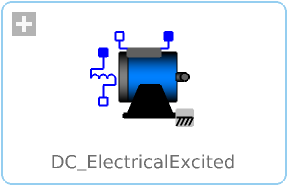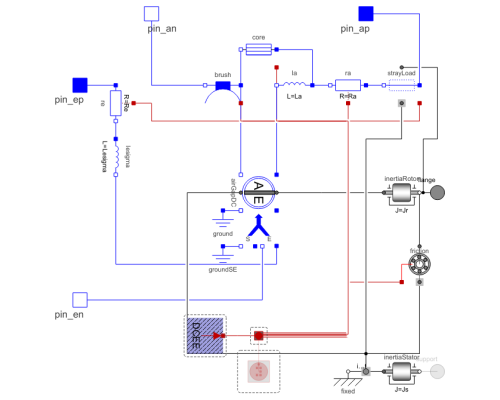WOLFRAM SYSTEM MODELER
DC_ElectricalExcitedElectrical shunt/separate excited linear DC machine |
|
Diagram
Wolfram Language
SystemModel["Modelica.Electrical.Machines.BasicMachines.DCMachines.DC_ElectricalExcited"]

Information
This information is part of the Modelica Standard Library maintained by the Modelica Association.
Model of a DC Machine with electrical shunt or separate excitation.
Armature resistance and inductance are modeled directly after the armature pins, then using a AirGapDC model.
The machine models take the following loss effects into account:
- heat losses in the temperature dependent armature winding resistance
- heat losses in the temperature dependent excitation winding resistance
- brush losses in the armature circuit
- friction losses
- core losses (only eddy current losses, no hysteresis losses)
- stray load losses
No saturation is modelled.
Shunt or separate excitation is defined by the user's external circuit.
Default values for machine's parameters (a realistic example) are:
| stator's moment of inertia | 0.29 | kg.m2 |
| rotor's moment of inertia | 0.15 | kg.m2 |
| nominal armature voltage | 100 | V |
| nominal armature current | 100 | A |
| nominal torque | 63.66 | Nm |
| nominal speed | 1425 | rpm |
| nominal mechanical output | 9.5 | kW |
| efficiency | 95.0 | % only armature |
| efficiency | 94.06 | % including excitation |
| armature resistance | 0.05 | Ohm at reference temperature |
| reference temperature TaRef | 20 | °C |
| temperature coefficient alpha20a | 0 | 1/K |
| armature inductance | 0.0015 | H |
| nominal excitation voltage | 100 | V |
| nominal excitation current | 1 | A |
| excitation resistance | 100 | Ohm at reference temperature |
| reference temperature TeRef | 20 | °C |
| temperature coefficient alpha20e | 0 | 1/K |
| excitation inductance | 1 | H |
| stray part of excitation inductance | 0 | |
| armature nominal temperature TaNominal | 20 | °C |
| armature operational temperature TaOperational | 20 | °C |
| (shunt) excitation operational temperature TeOperational | 20 | °C |
Armature current does not cover excitation current of a shunt excitation; in this case total current drawn from the grid = armature current + excitation current.
Parameters (24)
| Jr |
Value: Type: Inertia (kg⋅m²) Description: Rotor's moment of inertia |
|---|---|
| useSupport |
Value: false Type: Boolean Description: Enable / disable (=fixed stator) support |
| Js |
Value: Jr Type: Inertia (kg⋅m²) Description: Stator's moment of inertia |
| useThermalPort |
Value: false Type: Boolean Description: Enable / disable (=fixed temperatures) thermal port |
| frictionParameters |
Value: Type: FrictionParameters Description: Friction loss parameter record |
| TaOperational |
Value: Type: Temperature (K) Description: Operational armature temperature |
| VaNominal |
Value: Type: Voltage (V) Description: Nominal armature voltage |
| IaNominal |
Value: Type: Current (A) Description: Nominal armature current (>0..Motor, <0..Generator) |
| wNominal |
Value: Type: AngularVelocity (rad/s) Description: Nominal speed |
| TaNominal |
Value: Type: Temperature (K) Description: Nominal armature temperature |
| Ra |
Value: Type: Resistance (Ω) Description: Armature resistance at TaRef |
| TaRef |
Value: Type: Temperature (K) Description: Reference temperature of armature resistance |
| alpha20a |
Value: Type: LinearTemperatureCoefficient20 (1/K) Description: Temperature coefficient of armature resistance |
| La |
Value: Type: Inductance (H) Description: Armature inductance |
| coreParameters |
Value: Type: CoreParameters Description: Armature core loss parameter record |
| strayLoadParameters |
Value: Type: StrayLoadParameters Description: Stray load loss parameter record |
| brushParameters |
Value: Type: BrushParameters Description: Brush loss parameter record |
| IeNominal |
Value: Type: Current (A) Description: Nominal excitation current |
| Re |
Value: Type: Resistance (Ω) Description: Field excitation resistance at TeRef |
| TeRef |
Value: Type: Temperature (K) Description: Reference temperature of excitation resistance |
| alpha20e |
Value: Type: LinearTemperatureCoefficient20 (1/K) Description: Temperature coefficient of excitation resistance |
| Le |
Value: Type: Inductance (H) Description: Total field excitation inductance |
| sigmae |
Value: Type: Real Description: Stray fraction of total excitation inductance |
| TeOperational |
Value: Type: Temperature (K) Description: Operational (shunt) excitation temperature |
Outputs (9)
| phiMechanical |
Default Value: flange.phi - internalSupport.phi Type: Angle (rad) Description: Mechanical angle of rotor against stator |
|---|---|
| wMechanical |
Default Value: der(phiMechanical) Type: AngularVelocity (rad/s) Description: Mechanical angular velocity of rotor against stator |
| tauElectrical |
Default Value: inertiaRotor.flange_a.tau Type: Torque (N⋅m) Description: Electromagnetic torque |
| tauShaft |
Default Value: -flange.tau Type: Torque (N⋅m) Description: Shaft torque |
| powerBalance |
Type: PowerBalanceDCEE Description: Power balance |
| va |
Default Value: pin_ap.v - pin_an.v Type: Voltage (V) Description: Armature voltage |
| ia |
Default Value: pin_ap.i Type: Current (A) Description: Armature current |
| ve |
Default Value: pin_ep.v - pin_en.v Type: Voltage (V) Description: Field excitation voltage |
| ie |
Default Value: pin_ep.i Type: Current (A) Description: Field excitation current |
Connectors (9)
| flange |
Type: Flange_a Description: Shaft |
|
|---|---|---|
| support |
Type: Flange_a Description: Support at which the reaction torque is acting |
|
| internalSupport |
Type: Support Description: Support/housing flange of a one-dimensional rotational shaft |
|
| pin_ap |
Type: PositivePin Description: Positive armature pin |
|
| pin_an |
Type: NegativePin Description: Negative armature pin |
|
| thermalPort |
Type: ThermalPortDCEE Description: Thermal port of DC machine with electrical excitation |
|
| internalThermalPort |
Type: ThermalPortDCEE Description: Thermal port of DC machine with electrical excitation |
|
| pin_ep |
Type: PositivePin Description: Positive excitation pin |
|
| pin_en |
Type: NegativePin Description: Negative excitation pin |
Components (21)
| frictionParameters |
Type: FrictionParameters Description: Friction loss parameter record |
|
|---|---|---|
| inertiaRotor |
Type: Inertia Description: 1D-rotational component with inertia |
|
| inertiaStator |
Type: Inertia Description: 1D-rotational component with inertia |
|
| fixed |
Type: Fixed Description: Flange fixed in housing at a given angle |
|
| friction |
Type: Friction Description: Model of angular velocity dependent friction losses |
|
| coreParameters |
Type: CoreParameters Description: Armature core loss parameter record |
|
| strayLoadParameters |
Type: StrayLoadParameters Description: Stray load loss parameter record |
|
| brushParameters |
Type: BrushParameters Description: Brush loss parameter record |
|
| powerBalance |
Type: PowerBalanceDCEE Description: Power balance |
|
| ra |
Type: Resistor Description: Ideal linear electrical resistor |
|
| la |
Type: InductorDC Description: Ideal linear electrical inductor for electrical DC machines |
|
| brush |
Type: Brush Description: Model considering voltage drop of carbon brushes |
|
| core |
Type: Core Description: Model of core losses |
|
| strayLoad |
Type: StrayLoad Description: Model of stray load losses dependent on current and speed |
|
| thermalAmbient |
Type: ThermalAmbientDCEE Description: Thermal ambient for DC machine with electrical excitation |
|
| airGapDC |
Type: AirGapDC Description: Linear airgap model of a DC machine |
|
| ground |
Type: Ground Description: Ground node |
|
| compoundDCExcitation |
Type: CompoundDCExcitation Description: Compound excitation = shunt + series |
|
| groundSE |
Type: Ground Description: Ground node |
|
| re |
Type: Resistor Description: Ideal linear electrical resistor |
|
| lesigma |
Type: InductorDC Description: Ideal linear electrical inductor for electrical DC machines |
Used in Examples (1)
|
Modelica.Electrical.Machines.Examples.DCMachines Test example: DC with electrical excitation starting with voltage ramp |
Extended by (1)
|
Modelica.Electrical.Machines.BasicMachines.QuasiStaticDCMachines Quasi-static electrical shunt/separate excited linear DC machine |

